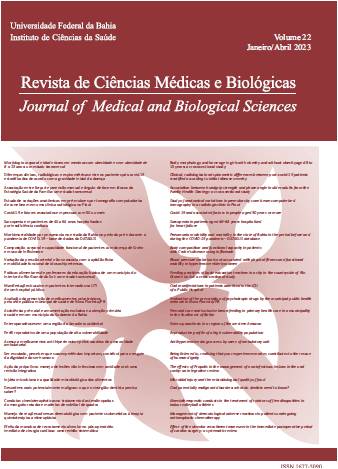Assistência pré-natal e amamentação exclusiva na atenção primária à saúde em um município do Sudoeste da Bahia
DOI:
https://doi.org/10.9771/cmbio.v22i1.49186Palavras-chave:
Assistência pré-natal, Amamentação exclusiva, Atenção Primária à Saúde, Saúde da CriançaResumo
Introdução: o aleitamento materno exclusivo deve ser promovido e fortalecido em todas as esferas públicas, especialmente na Atenção Primária à Saúde (APS), que tem o pré-natal como elemento importante para assistência e acompanhamento da mulher durante a gestação. Objetivo: identificar a associação entre assistência pré-natal e amamentação exclusiva em crianças menores de seis meses acompanhadas na APS em um município do Sudoeste da Bahia. Metodologia: estudo transversal, envolvendo 75 mães/crianças de zero a seis meses cadastradas no programa de Crescimento e Desenvolvimento do serviço de saúde do município de Jequié, Bahia, no período de março a agosto de 2018. Empregou-se o Teste de Qui-Quadrado de Pearson, para avaliar associação entre variáveis da assistência pré-natal e amamentação exclusiva. Resultados: a prevalência de aleitamento materno exclusivo registrado neste estudo foi de 36%. Observou-se que, mães com mais de seis consultas de pré-natal durante a gestação apresentaram maior prevalência de amamentação exclusiva (55,2%; p=0,019). A variável orientações sobre amamentação exclusiva no pré-natal não foi estatisticamente associada ao desfecho (0,457), porém descritivamente identificou-se que as mães que tiveram orientações durante o pré-natal apresentaram tendência de amamentar exclusivamente (56,7%; p= 0,457). Conclusão: a assistência pré-natal pode ser considerada elemento protetor na prática da amamentação exclusiva, e por isso a promoção e apoio ao aleitamento materno deve ser fortalecida na APS.
Downloads
Downloads
Publicado
Como Citar
Edição
Seção
Licença
Copyright (c) 2023 Revista de Ciências Médicas e Biológicas

Este trabalho está licenciado sob uma licença Creative Commons Attribution 4.0 International License.
A Revista de Ciências Médicas e Biológicas reserva-se todos os direitos autorais dos trabalhos publicados, inclusive de tradução, permitindo, entretanto, a sua posterior reprodução como transcrição, com a devida citação de fonte. O periódico tem acesso livre e gratuito.






